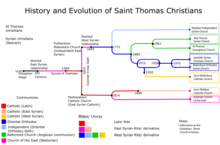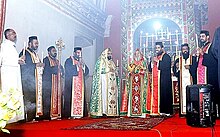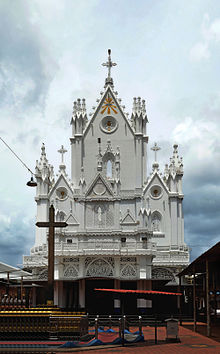Jacobite Syrian Christian Church: Difference between revisions
The christology followed by this church is Miaphysite |
Kokkarani, discussion is going on this topic at https://en.wikipedia.org/wiki/Talk:Oriental_Orthodoxy#Oriental Orthodoxy is a communion of some Churches? Pls present your points there |
||
| Line 8: | Line 8: | ||
|independance = Under Syrian Church, Not Independent |
|independance = Under Syrian Church, Not Independent |
||
|independence = [[Apostolic Age|Apostolic Era]] |
|independence = [[Apostolic Age|Apostolic Era]] |
||
|recognition = [[ |
|recognition = [[Oriental Orthodox]] |
||
|primate = [[List of Syriac Orthodox Patriarchs of Antioch|Syriac Patriarch]] [[Ignatius Aphrem II]] |
|primate = [[List of Syriac Orthodox Patriarchs of Antioch|Syriac Patriarch]] [[Ignatius Aphrem II]] |
||
|headquarters= [[Kochi]], [[India]] |
|headquarters= [[Kochi]], [[India]] |
||
Revision as of 23:00, 7 May 2017
| Jacobite Syrian Christian Church | |
|---|---|
 Syriac Orthodox Church Emblem | |
| Language | Malayalam, English, Hindi, Syriac |
| Headquarters | Kochi, India |
| Territory | India |
| Possessions | India, Europe, Australia, New Zealand, and North America |
| Independence | Apostolic Era |
| Recognition | Oriental Orthodox |
| Official website | jscnews.org |
| Part of a series on |
| Christianity in India |
|---|
 |


The Malankara Jacobite Syrian Orthodox Church,[2][3][4][5][6] officially known as Jacobite Syrian Christian Church,[7][8][9][10] is an integral branch of the Syriac Orthodox Church centered in Kerala, India. It recognizes the Syriac Orthodox Patriarch, currently Ignatius Aphrem II, as its supreme head. It functions as a largely autonomous unit within the church, under the authority of the Catholicos of India, currently Baselios Thomas I. Its members are part of the Saint Thomas Christian community, which traces its origins to the evangelistic activity of Thomas the Apostle in the 1st century.[11][12][13][14]
It is believed that Saint Thomas Christians of Malabar were in communion with the Church of the East from 496 to 1599.[15] They got episcopal support from Persian bishops, who traveled to Kerala in merchant ships through the spice route, while the local leader of the Saint Thomas Christians held the rank of Archdeacon and was a hereditary office held by the Pakalomattam family. In the 16th century, the overtures of the Portuguese padroado to bring the Saint Thomas Christians into Latin Rite Catholicism led to the first of several rifts in the community by Portuguese colonialists and the establishment of rival Catholic and Malankara Church factions. Since then, further splits have occurred, and the Saint Thomas Christians are now divided into several fragments. The Malankara Jacobite Church is one of three such groups that have remained part of Oriental Orthodoxy (the other being the Orthodox Syrian Church and Thozhiyoor Church).
Saint Thomas Christians were administratively under the single native dynastic leadership of an Archdeacon (അർക്കദിയൊക്കൊൻ) (a native ecclesiastical head with spiritual and temporal powers, deriving from Greek term arkhidiākonos) and were in communion with the Church of the East, centered in Persia, from at least 496.[16][17] The indigenous Church of Malabar/Malankara followed the faith and traditions handed over by the Apostle St. Thomas. During 16th century, the Portuguese Jesuits began deliberate attempts to annex the native Christians to the Catholic Church, and in 1599 they succeeded through the Synod of Diamper. Resentment against these forceful measures led the majority of the community under the Archdeacon Thomas to swear an oath never to submit to the Portuguese, known as the Coonan Cross Oath, in 1653. The Malankara Church consolidated under Mar Thoma I welcomed Gregorios Abdal Jaleel, who regularized the canonical ordination of Mar Thoma as a Bishop.
Meanwhile, the Dutch East India Company defeated the Portuguese in supremacy of the spice trade in Malabar in 1663. The Malankara church used this opportunity to escape from Catholic persecution with the Dutch East India Company's help. At the request of the Malankara Church, the Dutch brought Gregorios Abdal Jaleel of Jerusalem, a bishop of the Syriac Orthodox Church, in their trading vessel in 1665. Mar Thoma I forged a relationship with the Syriac Orthodox Church and gradually adopted West Syrian liturgy and practices.
History
Please see
As part of the Syriac Orthodox communion, the church uses the West Syrian liturgy and is part of the Oriental Orthodox group of churches. It has dioceses in most parts of India as well as in the United States, Canada, the United Kingdom, Western Europe, and the Persian Gulf nations. In 2003 it was estimated that the church has 1,200,000 members globally.[18]
Name
The Malankara Jacobite Syrian Orthodox Church has been known by several names during its existence. Other variants include Jacobite Syrian Christian Church,[19] Malankara Syrian Orthodox Church, and Jacobite Syrian Church.[20]
Headquarters
Puthencruz is the headquarters of the Jacobite Syrian Christian Church in India. The headquarters is situated near the St. Peter's and St. Paul's Jacobite Syrian church. Its headquarters is named after the illustrious Patriarch of Antioch Ignatius Zakka I Iwas. The property was bought and built under the leadership of the Catholicos of India Mar Baselios Thomas I, after the church faced difficulties in continuing its functioning from its base at Muvattupuzha with the demise of Catholicos Mar Baselios Paulose II.
The Catholicossate chapel is named after Poulose Mar Athanasius of Aluva and under the chapel is situated the space for tombs for the use of future Catholicos of the church. An Arts and Science college named after Mar Athanasius of Aluva is also run in the premises of the Zakka centre. It is the place where Akhila Malankara Suvisesha Yogam, the official gospel convention of the community, that is generally conducted from 26 to 31 December of every year. The official publishing house of the church, JSC Publishers are also a part of the large complex.Its subsidiary institutions such as the Malankara Jacobite Syrian Sunday School Association (MJSSA) is also based in Puthencruz.

Catholicos of India
Catholicose of India is an ecclesiastical office in the Syriac Orthodox Church, the head of the Jacobite Syrian Christian Church in Kerala, India. He is the Catholicos/Maphrian of the Jacobite Syrian Christian Church an autonomous body within the Syriac Orthodox Church, and functions at an ecclesiastical rank second to the Syriac Orthodox Patriarch of Antioch. The jurisdiction of the Syriac Orthodox Catholicos is limited to India, and he presides provincial synod.[21] The current Catholicos of India is Catholicos Baselios Thomas I, who was consecrated in 2002.
The position was created in the 20th century, amid a series of splits within the local Malankara Syrian Church that divided the community into rival Jacobite Syrian and Indian Orthodox factions. It was instituted to provide a regional head for Jacobite Syrian Church, the faction that remained closely aligned with the Patriarch of Antioch.
Catholicos Baselios Thomas I (Mal: ആബൂന് മോര് ബസേലിയോസ് തോമസ് പ്രഥമന് കാതോലിക്ക ബാവ, b: July 22, 1929) is the second Maphrian i.e. Catholicos of the Syriac Orthodox Church in India and Metropolitan Trustee of the Jacobite Syrian Christian Church.
His official title is Catholicos of India. On 26 July 2002 he was enthroned as the second Catholicos and the head of the Malankara Jacobite church in India by the Patriarch Ignatius Zakka I Iwas, in a ceremony held in Damascus, Syria. The position had remained vacant between 1996 (date of death of Catholicos Baselios Paulose II) and 2002.
Saints of the Church
- Ignatius Elias III - Patriarch Of Antioch (Entombed in Manjanikkara Dayara at Omallur)
- Mor Baselios Yeldo - Catholicos of Persia (Entombed in Kothamangalam Cheria Pally)
- Parumala Thirumeni - (Geevarghese Mor Gregorious, Entombed in Parumala Church)
- Paulose Mar Athanasius - Methropolitian of Jacobite Syrian Church (entombed in Aluva Thrikkunnathu Seminary)
- Mor Koorilos Paulose - Malankara Metropolitan (Entombed in Panampady Church)
- St. Koorilos Yuyakkim - Reesh-Episcopa of Malankara (Entombed in Mulanthuruthy Marthoman Church)
- St. Osthatheos Sleeba - Apostolic delegate of the Holy See to India (Entombed in Arthat St.Mary's Simhasana church, Kunnamkulam)
- Baselios Sakralla III of Aleppo - Maphryono (entombed at Morth Mariam Cathedral, Kandanad)
- Gregorios Abdal Jaleel - Syrian Orthodox Metropolitan of Jerusalem (entombed at St. Thomas Church North Paravur)
Dioceses
The Jacobite Syrian Orthodox Church has the following dioceses





Archdioceses (Autonomous)
There are Archdioceses under the jurisdiction of the Patriarch of Antioch:
- Knanaya Archdiocese
- Region of Chingavanam
- Region of Kallisseri
- Region of Ranni
- Region of USA, Canada and Europe
- Malankara Archdiocese of North America
- Malankara Archdiocese of Europe
- Patriarchal Vicarate of Ireland
- Patriarchal Vicarate of UK
- Patriarchal vicarate of Germany & Central Europe
Dioceses in Kerala
- Trivandrum
- Kollam Diocese[22]
- Thumpamon Diocese[23]
- Niranam Diocese[24]
- Kottayam Diocese[25]
- Idukki Diocese[26]
- Kandanad Diocese[27]
- Kochi Diocese[28]
- Angamaly(Largest Diocese)
- Angamaly Region
- Perumbavoor Region
- Kothamangalam Region
- Highrange Region
- Muvattupuzha Region
- Pallikkara Region
- Thrissur Diocese[29]
- Kozhikode Diocese[30]
- Malabar Diocese[31]
Dioceses in Rest of India
- Mangalore DIocese
- Bangalore DIocese
- Mylapore DIocese[32] (formerly Chennai Diocese)
- Bombay Diocese
- New Delhi Diocese[33]
Dioceses in Outside India (Autonomous)
- Middle East Diocese - Kuwait, Qatar, Bahrain, UAE, Oman, Saudi Arabia, Yemen
- Australia & New Zealand
- Singapore & Malaysia
Other Dioceses (Autonomous)
There are dioceses under the jurisdiction of the Patriarch of Antioch.
- Honavar Mission[34]
- E.A.E (Evangelistic Association Of The East) Churches[35]
- Simhasana Churches
Present Synod
The Synod of the Jacobite Syrian Orthodox Church comprises:
- Catholicos Baselios Thomas I
- Kuriakose Mor Severios Edavazhikal (Knanaya)
- Abraham Mor Severious
- Thomas Mor Timotheos
- Joseph Mor Gregorios
- Mathews Mor Ivanios
- Geevarghese Mor Dionysius
- Kuriakose Mor Dioscorus
- Geevarghese Mor Athanasios (Simhasana Churches)
- Kuriakose Mor Theophilos
- Yuhanon Mor Militos
- Mathews Mor Theodosius
- Mathews Mor Aphrem
- Pathros Mor Osthathios
- Geevarghese Mor Coorilose
- Yeldho Mor Theethose
- Kuriakose Mor Eusabios
- Markose Mor Chrisostamos
- Elias Mor Athanasios
- Kuriakose Mor Gregorios (Knanaya)
- Yaqu'b Mor Anthonios
- Zacharias Mor Philoxenos
- Paulose Mor Irenious
- Kuriakose Mor Ivanious (Knanaya)
- Ayub Mor Silvanious (Knanaya)
- Geevarghese Mor Barnabas
- Issac Mor Osthathios
- Kuriakose Mor Julios
- Thomas Mor Alexandros
- Zacharias Mor Polycarpus
- Mathews Mor Thimothios
- Mathews Mor Anthimos
See also
- Catholicos
- List of Patriarchs of Antioch – to 518
- List of Syriac Orthodox Patriarchs of Antioch – list from 518
- Related
- List of Orthodox Churches
- Saint Thomas Christians
- Malankara Orthodox Syrian Church
- Malankara Metropolitan
- Malankara Throne
- Manarcad church
References
- ^ "CNEWA Canada - The Malankara Orthodox Syrian Church".
- ^ Russell, Thomas Arthur; Comparative Christianity: A Student's Guide to a Religion and Its Diverse Traditions(English) Boca Raton, Florida;2010; Universal Publishers; p 40.
- ^ Gregorios; Paulos; Roberson; Ronald G.; The Encyclopedia Of Christianity Online (Syrian Orthodox Churches in India)(English) Netherlands;2016; Brill Online Reference works.
- ^ Lucian N. Leustean; Eastern christianity and the cold war, 1945-91(English) New York;2010; Routeledge Taylor&Francis Group; p.317.
- ^ Erwin Fahlbusch; The Encyclopedia of Christianity, Volume 5(English);2008; Wm. B. Eerdmans Publishing;p. 285.
- ^ Frykenberg, Eric; Christianity in India: from Beginnings to the Present(English); Oxford University Press; p 374.
- ^ "JSC News - The Official News Portal of Holy Jacobite Syrian Christian Church".
- ^ Pastoral message of H.B Thomas I,Catholicos of India, Jacobite Church Head in India
- ^ Official Publication of Jacobite Syrian Christian Church
- ^ "Jacobite Syrian Christian Church Constitution 2002 (in Malayalam)" (PDF).
- ^ Menachery G (1973) The St. Thomas Christian Encyclopedia of India, Ed. George Menachery, B.N.K. Press, vol. 2, ISBN 81-87132-06-X, Lib. Cong. Cat. Card. No. 73-905568; B.N.K. Press – (has some 70 lengthy articles by different experts on the origins, development, history, culture... of these Christians, with some 300 odd photographs).
- ^ Leslie Brown, (1956) The Indian Christians of St. Thomas. An Account of the Ancient Syrian Church of Malabar, Cambridge: Cambridge University Press 1956, 1982 (repr.)
- ^ Thomas Puthiakunnel, (1973) "Jewish colonies of India paved the way for St. Thomas", The Saint Thomas Christian Encyclopedia of India, ed. George Menachery, Vol. II., Trichur.
- ^ NSC Network (2007) St. Thomas, India mission- Early reference and testimonies
- ^ [1]
- ^ Frykenberg, p. 93.
- ^ Wilmshurst, EO, 343
- ^ Fahlbusch, Erwin; Lochman, Jan Milic; Mbiti, John S.; Vischer, Lukas; Bromiley, Geoffrey William (2003). The Encyclopedia Of Christianity (Encyclopedia of Christianity) Volume 5. Wm. B. Eerdmans Publishing Company. pp. 285–286. ISBN 0-8028-2417-X.
- ^ Leustean, Lucian N. (2014). Eastern Christianity and Politics in the Twenty-First Century. Routledge. p. 585. ISBN 1317818660.
- ^ Russell, Thomas Arthur (2010). Comparative Christianity: A Student's Guide to a Religion and Its Diverse Traditions. Boca Raton, Florida: Universal Publishers. p. 40. ISBN 1599428776.
- ^ "Catholicate of the East".
- ^ "Kollam Diocese of Jacobite Syrian Church". Retrieved 5 March 2015.
- ^ "Home". Retrieved 5 March 2015.
- ^ "Niranam Diocese of Jacobite Syrian Christian Church". Retrieved 5 March 2015.
- ^ "Kottayam Diocese". Retrieved 5 March 2015.
- ^ "Official website of Idukki Diocese". Retrieved 5 March 2015.
- ^ "Kandanad Diocese - Jacobite Syrian Christian Church". Retrieved 5 March 2015.
- ^ "Kochi Diocese".
- ^ "Home". Retrieved 5 March 2015.
- ^ "Kozhikode Diocese". Retrieved 5 March 2015.
- ^ "Official Website of Malabar Diocese, Jacobite Syrian Christian Church". Retrieved 5 March 2015.
- ^ "Mylapore Diocese". Retrieved 5 March 2015.
- ^ "Delhi Diocese of Jacobite Syrian Church". Retrieved 5 March 2015.
- ^ "Honnavar Mission". Retrieved 5 March 2015.
- ^ Visuals,Cochin, Tek Web. "The Evangelistic Association of the East".
Complete video of the Holy Mass [Holy Qurbano] of the Jacobite Syrian Church:
External links
![]() Media related to Jacobite Syrian Christian Church at Wikimedia Commons
Media related to Jacobite Syrian Christian Church at Wikimedia Commons



